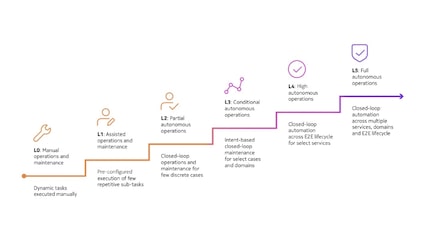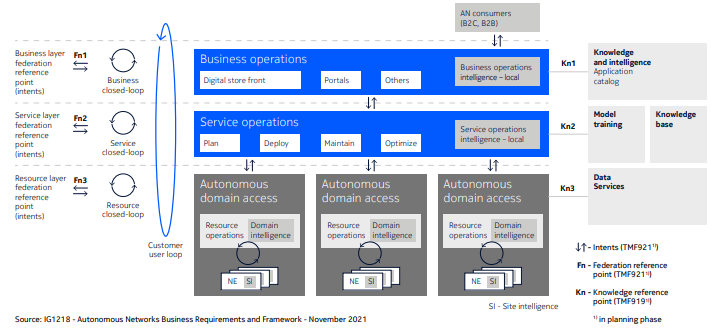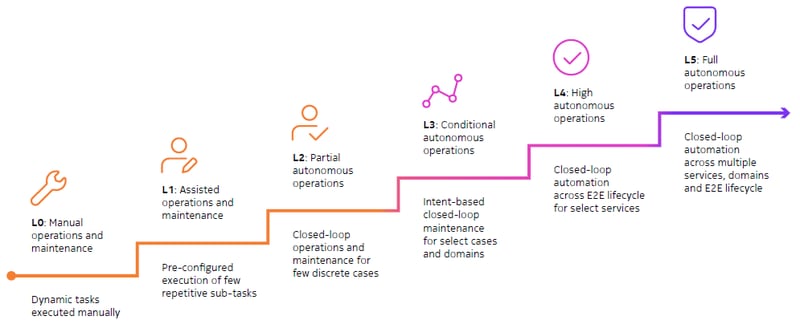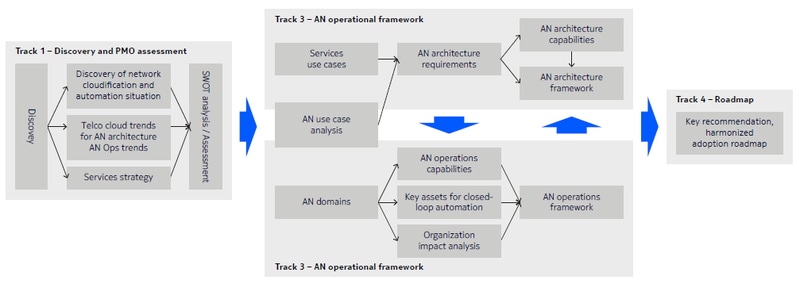Communication service providers strive ceaselessly to increase customer satisfaction by delivering new services with innovative technologies while under constant pressure to reduce costs. The ongoing introduction of new services and technologies, however, frustrates cost reduction goals as additional interactive components and overlay systems add costly operational complexity. Even customer satisfaction, which relies heavily on service reliability and fulfillment speed, can be negatively impacted by the increased operational and technical complexity of new technologies.
The main way to solve this conundrum is to increase automation, ideally culminating in a fully autonomous network. To implement closed loop automation in the network requires capturing “intents”, which describe the target state of the network and/or network components in a machine digestible way, and orchestrating the network and its components to support the expressed intents reliably and with service assurance end to end.
APIs play a key role in implementing end-to-end automated closed-loop assurance by connecting processes across all layers and technologies of today’s highly complex networks. To ensure maximum flexibility, interoperability and future flexibility, service providers, vendors and third-parties rely on industry standardized APIs.
Autonomous network operations architecture
CSP autonomous networks are structured in three layers (per figure 1). On the lowest layer, resources within an autonomous domain (AD) are managed in a closed loop. Example ADs include radio access, transmission and core networks, which may be further differentiated per region and/or vendor. The service layer above the ADs, services operations, manages the individual networks and components in a coherent and dynamic manner, which forms a second closed loop. The service outcome or intent is made at the third layer, business operations, which forms a third closed loop.
Figure 1. Autonomous networks operations architecture
The three closed loops taken together establish the customer/user closed loop, which delivers the subscribed service in an automated fashion. Each loop comprises different components suchas monitoring, analytics, orchestration and resource control, with autonomy only reachable if each of the components embedded in the closed loop is working in full automation.
The industry (TM Forum) classifies autonomous networks (AN) in respect to their state of autonomy (figure 2) from “L0” (manual operations) to “L5” (fully autonomous network). The majority of CSPs are understood to be at an autonomy level between “L1” (assisted operations and maintenance) and “L2” (partial autonomous networks).
Figure 2. TM Forum classification of networks by level of automation
Bell Labs Consulting capabilities
Bell Labs Consulting is uniquely positioned to support you in navigating the technical and operational aspects of your evolution to full network autonomy. We will begin by assessing your current status, not only in terms of the TM Forum AN maturity levels (figure 2), but with an increased level of detail for prioritizing and undertaking further actions.
We will identify, assess and develop use cases suitable for progressing to full network autonomy based on your current status and in full consultation with your internal teams and partners. Based on your current maturity and the most relevant use cases, we will make actionable recommendations and create a roadmap combining the most current technological and operational approaches with Bell Labs Consulting’s extensive experience in both areas
The Bell Labs Consulting approach
A typical Bell Labs Consulting engagement is structured according to the methodology represented in figure 3. Dependent on your concrete needs, different activities will be emphasized, added or removed.
Figure 3. The Bell Labs Consulting structured methodology
For further information please contact us at info.query@bell-labs-consulting
Bell Labs Consulting Bell Labs Consulting provides impartial advice to help clients realize the full economic, social, and human potential of future technologies.



